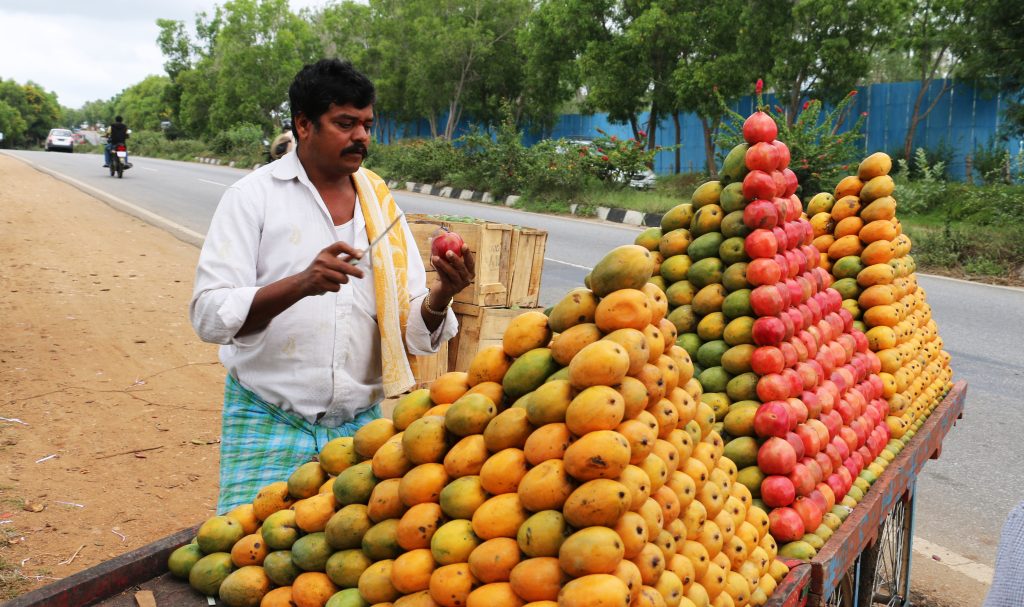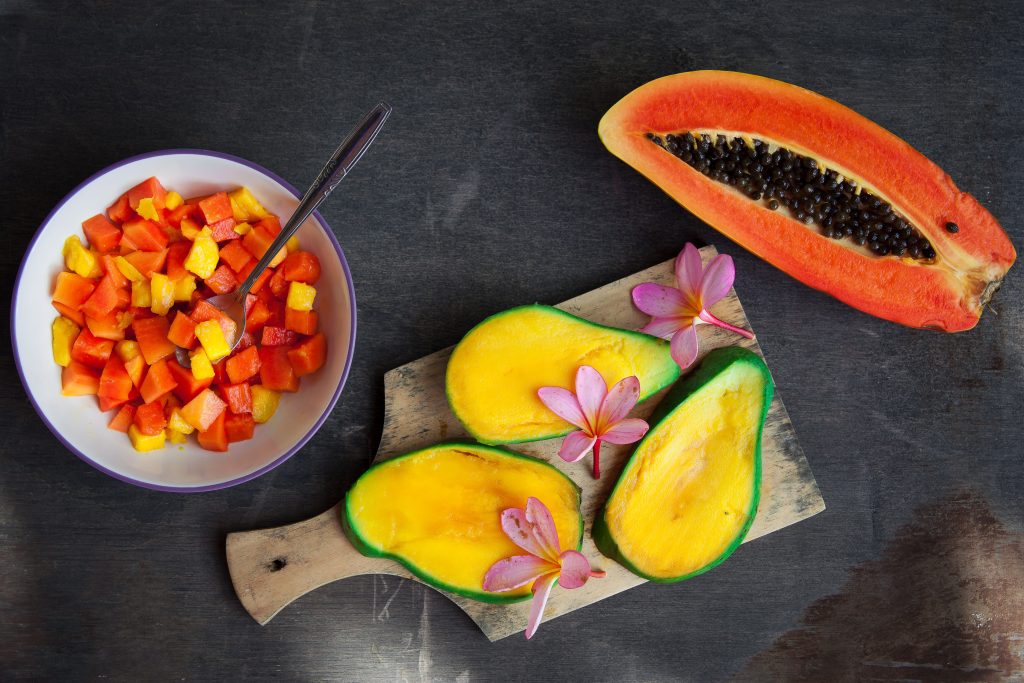The mango (Mangifera indica) is a popular tropical fruit belonging to the Anacardiaceae family. Grown in over 100 different countries worldwide, mangos are internationally recognized as one of the most important tropical fruits.
Table of Contents
What is a Mango?
Mango fruits are drupes like peaches, cherries, and plums, meaning they have an outer skin, fleshy insides, and a middle seed.
Because there are hundreds of different mango varieties, the fruit’s physical form will widely vary. In general, it’s typically oval or round, with smooth, red and yellow skin.
When you cut into a ripe mango, the color of the flesh will vary from yellow to deep orange. Mangos are typically very juicy and have a bright, melon-like and citrusy flavor.
The History of Mangos
Mangos first appeared over 5,000 years ago in the Hindo-Berma area, stretching from Eastern India and Southern China across Southeast Asia. Mango cultivation spread westward with the spice trade, and the Portuguese were the first to start a mango trade after arriving in Calcutta in 1498.
Mango seeds first traveled from Asia to the Middle East, East Africa, and South America around 300 A.D. Eventually, Spanish colonizers introduced mangos to South America and Mexico in the 1600s.
Mango trees and mango leaves symbolize eternal love and wealth, and are used for certain holy celebrations in Hindu mythology. They’re also seen as a symbol of good luck for everyone that hangs them up. An International Mango Festival is held annually in India, showcasing mango plants and their fruits.

What Does a Mango Taste Like?
Fresh, ripe mangos are often described as sweet, citrusy, and almost melon-like. Some consider their flavor a cross between a peach, an orange, and a melon, while others think they have a more tropical and floral flavor, similar to papaya and pineapple.
If they’re not entirely ripe, raw mangos can sometimes seem sour. If you don’t enjoy them raw, you can try cooking them to help them taste sweeter. Different cultivars of mango will offer distinct flavors, so it’s a good idea to try mangos from other regions of the world.
How to Tell When Mango is Ripe
Picking out a perfectly ripe mango will vastly improve your cooking and eating experience. Here are a few tips on how to find an ideal mango:
| Firmness | When gently pressed, the outer layer of skin gives slightly. Unripe mango will be hard as a rock, and an overripe mango will be overly soft and marks will appear when pressed or touched. |
| Scent | Ripe mangos have a fruity, almost floral aroma near where they connect to the stem. This is one of the best indicators when searching for ripe mangos. |
| Texture | Many young mangos will have a smooth, matte surface about them when being held. Ripened mangos often appear shiny or waxy and tend to have a stickier texture when held. |
| Color | As they ripen, mangos often change from green to orange, red, or rosy. However, some ripe mangos will retain their green color, so we recommend inspecting their color as a last resort. |
Are Mangos and Papayas Related?
Mangos and papayas are two of the most popular fruits consumed throughout India. Despite having a similar structure, these two fruits are distinct and frequently confused by people.
Despite their similar appearances, mangos and papayas taste very different from one another. While mangos have complex spicy and floral flavor notes, papayas are known for their creamy, musky flavors, more akin to melons.
They may look the same in pictures, but it’s easy to distinguish a mango from a papaya in person. Papayas are pumpkin-shaped fruits with bright greenish-yellow skin, vibrant orange flesh and many black seeds in the center, while mangos are smaller with a gradient of red, green, and yellow skin. Mangos typically have golden-yellow flesh and only one large, flat seed in the center.

Cooking with Mango
To prepare mango, follow these four simple steps:
- Cut the fruit slightly off of the center of the fruit in order to miss the seed.
- Slice the fresh mango with a slight curve around the stone. Do the same on the other side: leave some flesh with the seed in the center.
- Then, you can scoop out this fresh fruit’s fleshy part or cut it into cubes.
- Finally, scoop out the stone and peel the skin away from the flesh.
Here are a few recipes we recommend if you want inspiration for your next mango dish or drink!
- Instant Mango Chutney: Chutneys are essentially spiced jams that are a great way of adding fruity and spicy flavors to any Indian dish.
- Churumuri: Churumuri is famous Indian street food consisting of puffed rice, vegetables, mango, and various herbs and spices. This recipe is an excellent introduction to churumuri and will make you want to try it in India!
- Aam Panna: This is a traditional Indian summer drink that combines mango, cumin, cardamom, salt, black pepper, and more.

How to Store Mangos
Store firmer mangos at room temperature until ripe and then put in the fridge only as needed, for no more than five days, which will slow down the ripening process.
Mangos can be peeled, cubed, and placed in an airtight container in the refrigerator for several days or in the freezer for up to six months.
Nutritional Benefits of Mango
Raw mangos are known to help improve digestion and prevent problems such as acidity, indigestion, constipation, and morning sickness. They also benefit the immune system, helping reduce the risk of blood disorders and diseases.
The antioxidants present in raw mangos help to reduce inflammation and cancer risk. The nutrients in green mangos help to promote healthy skin and hair, as well as collagen synthesis.
Mangos also contain plenty of magnesium and potassium, which help our heart function properly. We can also get a healthy dose of carbohydrates from mangos, which offer a natural source of beta-carotene and carotenoids.
They’re also a good source of healthy polyphenols and folate. These include substances that can help protect the body from disease.
Where to Purchase Mangos
Mangos can be purchased in most supermarkets since they’re popular fruits and widely distributed. The best time to buy mangos is from May to September, but you can find them all year round.
The most common types of mangos found in grocery stores are Tommy Atkins, Kent, and Haden mangos.

